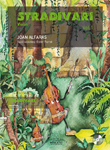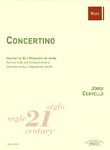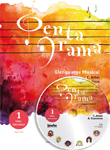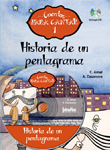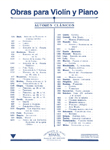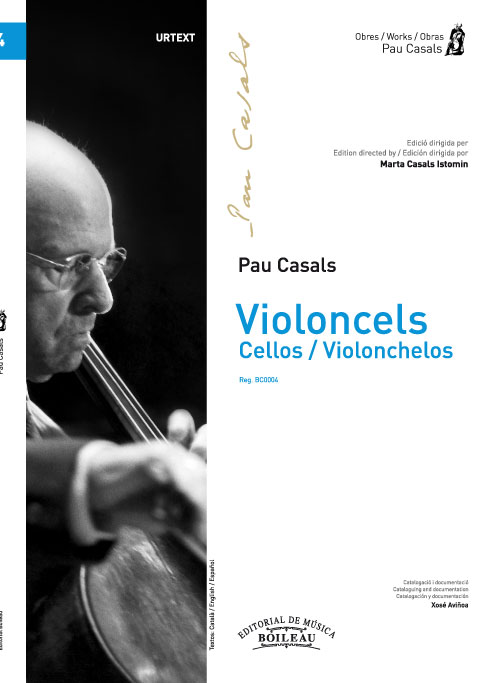Violoncels / Cellos / Violonchelos
Grupo de Violonchelos
CASALS, Pau; CASALS, PabloReg.: BC0004
25,30 €
P.V.P. (VAT included 4%)
Add to cart
- Review: CASALS ISTOMIN, Marta
- Ensemble: String orchestra: .
- Genres: Classical / contemporary: Chamber.
Folk music / traditional: Sardanas.
- Language of the comment: Català/English/Castellano
- Product format: Partitura
- Difficulty level: Intermediate
- Period: 2nd half S. XX - XXI
- Publishing house: Editorial Boileau
- Collection: Pau Casals
- No. of pages: 56
- Measure: 31,00 x 23,00 cm
- Lenght: 14'40"
- ISBN: 978-84-8020-905-2
- ISMN: 979-0-3503-0850-5
- Available in digital: No
- Available for rent: No
THE MATERIALS ARE SOLD SEPARATELY
An ensemble like the cello orchestra is unprecedented in the history of instrumentation. We know that the formation of orchestras arose out of the desire to work together on the premise of a balance of parts between the four bowed string instruments, the family made up of violin, viola, cello and double bass which had already played a prominent role in early chamber ensembles such as the concerto grosso. The later expansion of the orchestra with woodwind and brass instruments sought a better distribution of the range of timbric colours, a range which called for compositions for this kind of ensemble, but at no point was an orchestra or chamber ensemble made up of different instruments of the same musical colour imagined.
The twentieth century, with its unabated research into new sound organisations and new timbric effects, explored the possibilities of very diverse groupings made up of both analogue and electro-acoustic instruments. The closest existing formation to the cello orchestra is the saxophone ensemble, which is made up of seven members of the saxophone family (sopranino, soprano, alto, tenor, baritone, bass and double bass) and, in this case, allows a certain range of tessitura and tuning within the bounds of a sound produced via what is essentially the same mechanism: the vibration of a channel of air.
The cello orchestra is therefore a completely original grouping which one ought to associate closely with the creative and interpretative work of Pau Casals. A player, composer and by now well-established conductor, it was he who, in the nineteen twenties, conceived of the eight cello formation, for which he composed his Sardana Sant Fèlix para orquesta de violonchelos (Sardana Sant Fèlix for cello orchestra) (c. 1925). Other similar formations have appeared in the wake of the cello orchestra, for the most part made up of groups of pedagogical affinity. The work required by these three pieces for cello orchestra has much to do with the concept of the orchestral or chamber ensemble, in which we have, in some pieces more obviously than in others, lead roles on the one hand and support harmony and counterpoint roles on the other.
II.D-2.-Sardana Festa Major de Vilafranca del Penedès per a orquestra de violoncels (Sardana for cello orchestra for local festivity of Vilafranca del Penedés)
In 1927 Pau Casals dedicated this work to the London Cello School. Later it was orchestrated by Enric Casals with the title «Festa Major de Vilafranca». This is the only one of the three pieces composed exclusively for this instrumental formation and therefore involves a rich and imaginative distribution of parts and the role of each instrument. It reveals the knowledge that Casals had of the instrument and its expressive and discursive potential, offering a dense and thematically rich piece. The piece is a concert sardana with a more complex structure than the norm, and which is therefore not subject to the rules regarding the curts (shorts) and llargs (longs)that the genre demands.
Using its main key, C Mayor, as a starting point, the Sardana per a orquestra de violoncels is developed with a certain tonal oscillation, often alternating between E Major or D Major and incorporating other undefined chromatic modifications, as is often the case with Casal’s scores. It is characteristic of this piece and therefore perfectly justifiable, meanwhile, with it being a sardana, that it evokes the sounds of certain traditional instruments, such as the gralla and the drum, thus emphasising the link between the piece and popular Catalan tradition.
II.D-3c.-Sant Martí del Canigó per a orquestra de violoncels (Sant Martí del Canigó for cello orchestra)
This edition presents the Enric Casal’s transcription for cello ensemble of the theme of the Sant Martín del Canigó sardana. Originally written for piano by Pau Casals in 1943, it also gave rise to a version for chamber orchestra in 1950. Musically it is very far removed from the Sardana Sant Fèlix para orquesta de violonchelos, in that it is a mere transcription into five parts of the key sound elements, for solo cello and four other voices. The main discourse is not always played by the first cello, though the overall effect produced is that of a soloist with accompaniment in which the ensemble reinforces some of the main themes and, of course, the volume of the piece. A piece composed to form part of the dances, in this version it is its ‘concert-esque’ and contemplative aspect stands out the most, thanks to the orchestral subterfuges.
II.E-7d.- El cant dels ocells per a orquestra de violoncels (Bird Song for cello orchestra)
It is well known that, throughout his life, Pau Casals worked to popularize the traditional Catalan folk song, El cant dels ocells (Bird Song), investing it with a personality it simply did not have until reaching its current anthemic status, being used as an emblem on many solemn occasions, particularly as motif of collective meditation at commemorative events. As has already been indicated in a previous volume of this collection, Casals wrote his first version for cello and piano in 1941, probably inspired by touch of nostalgia during the first months of his exile to France. He has also written a version for soprano and choir and another for cello and chamber orchestra (1942).
The version for cello ensemble arose from the need to provide this unique formation a suitable repertoire and, as one would expect, the piece is developed according to the usual patterns in terms of its theme and accompaniment: a lead cello performs the central theme while the rest join together to enrich the accompaniment, doubling-up and magnifying the sound.
Sardana
Sant Martí del Canigó
El cant dels ocells

